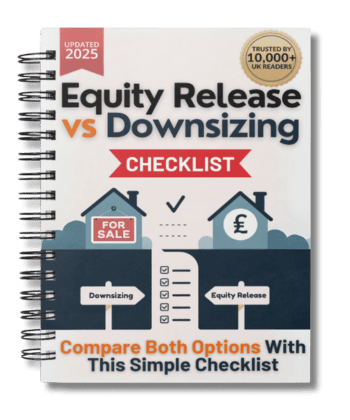
Best Equity Release Rates in the UK in 2025: Compared & Reviewed
See How Much You Could Release
In Just 60 Seconds — No Fees, No Obligation.
How Much Could You Unlock?
Why Homeowners Trust Us
Try Our Free Equity Release Calculator
Quick, Safe Estimate

No Commitments

No Hidden Fees
Trusted by Over 20,000 UK Homeowners!
 Be aware. Equity release comes with drawbacks which are important to think about. Lifetime mortgages are secured loans. Compound interest means the amount you owe can grow quickly. Equity release reduces your estate's value and may impact means-tested benefits.
Be aware. Equity release comes with drawbacks which are important to think about. Lifetime mortgages are secured loans. Compound interest means the amount you owe can grow quickly. Equity release reduces your estate's value and may impact means-tested benefits.Key Takeaways
- Lifetime mortgage rates in 2025 average between 5% and 7%, but vary by age and product type.
- Older applicants often qualify for lower rates due to higher loan-to-value (LTV) allowances.
- Fixed interest rates are most common, providing long-term certainty.
- Compound interest applies, so rates significantly affect the total amount repaid.
- Using a whole-of-market broker can help you find the most competitive offers.
- Market trends, inflation, and lender competition all influence rates.
- Early repayment charges and flexible repayment options should also be considered when choosing a deal.
Equity release rates have become more competitive, reflecting the financial industry’s response to homeowner needs, and with rates as low as 2.5%, this new benchmark sets a standard for affordability in the sector.
Providers now emphasise no negative equity guarantees and flexible repayment options, ensuring that homeowners can access their equity without the risk of debt exceeding their home’s value.
Did you know that in 2025, the landscape of equity release rates is more dynamic than ever? With rates hitting historic lows, missing out could mean losing thousands of pounds. This guide dives deep into the market, ensuring you don’t leave money on the table.
Keep reading to uncover hidden gems in the equity release market and discover how to secure the best equity release deals to safeguard your financial future.
Therefore:
What Are the Current Equity Release Interest Rates in the UK for 2025?
Interest rates for equity release in the UK currently range from 6.07% to 7% (MER), with the most competitive deals available to older applicants and those with higher-value properties. These rates are influenced by the Bank of England’s base rate, which stood at 4.75% in late 2024, and are typically higher than standard mortgage rates due to the long-term nature and risk profile of these products.
| Provider | Scheme Name | Monthly (Rate) | Annual Equivalent (Rate) | Annual Percentage (Rate) |
|---|---|---|---|---|
| Pure Retirement | Age Partnership Classic Flexible Lump Sum 1 | 5.97% | 6.14% | 6.14% |
| Canada Life | Age Partnership Ultra Lite Fixed ERC | 6.13% | 6.31% | 6.31% |
| Canada Life | Capital Select Ultra Lite Fixed ERC | 6.16% | 6.34% | 6.34% |
| Aviva | Age Partnership Lifestyle Flexible Option, Fixed ERC | N/A | 6.35% | 6.30% |
| Canada Life | Age Partnership Ultra Lite Plus Fixed ERC | 6.20% | 6.38% | 6.30% |
| Canada Life | Capital Select Ultra Lite Plus Fixed ERC | 6.24% | 6.42% | 6.38% |
| Just Retirement | Age Partnership J1 Lump Sum (>25% Payments) Fixed ERC (Enhanced) | 6.25% | 6.43% | 6.42% |
| Just Retirement | Age Partnership J1 Lump Sum (>25% Payments) Fixed ERC (Enhanced) | 6.25% | 6.43% | 7.20% |
| Canada Life | Age Partnership Super Lite Fixed ERC | 6.27% | 6.45% | 7.20% |
| Just Retirement | Age Partnership J2 Lump Sum (>25% Payments) Fixed ERC (Enhanced) | 6.28% | 6.46% | 6.45% |
Updated: 18/02/2025
Scenario: 60-year-old single male with a £300,000 property value, who wants to release £30,000.
Compare the Best Equity Release Rates and Lifetime Mortgage Deals in 2025
When comparing equity release deals, it’s essential to look beyond headline rates. Consider product features, flexibility, and provider reputation. Here’s a snapshot of some of the most competitive rates as of July 2025:
| Provider | Product Name | MER | AER | Notable Features |
|---|---|---|---|---|
| Pure Retirement | Classic Flexible Lump Sum 1 | 5.97% | 6.14% | Flexible drawdown, fixed ERC |
| Canada Life | Ultra Lite Fixed ERC | 6.13% | 6.31% | Fixed early repayment charges |
| Aviva | Lifestyle Flexible Option | N/A | 6.35% | Inheritance protection options |
For a full comparison, see the Top 10 Equity Release Companies in the UK 2025 Review.
How Does Equity Release Interest Work and What Is Its Impact on Your Plan?
Equity release interest is usually fixed for life and compounds over time, meaning interest accrues on both the original loan and any previously accumulated interest. This can significantly increase the total amount owed, impacting the inheritance left for beneficiaries. For example, a £50,000 loan at 6% interest could more than double in 15 years if no repayments are made.
Fixed vs Variable Rates
- Fixed rates provide certainty and stability over the lifetime of your plan.
- Variable rates may offer savings if market rates fall but can also increase your repayment amount if rates rise.
Understanding APR, MER, and AER
- AER (Annual Equivalent Rate): Typically used for savings, not loans, but sometimes referenced for comparison.
- APR (Annual Percentage Rate): Reflects the yearly cost of the loan, including interest and fees.
- MER (Monthly Equivalent Rate): Shows the monthly interest cost, useful for understanding compounding.

This means you don't need to repay until the property is sold, move into care, or pass away.

Equity Release Examples & Real-Life Scenarios
Let’s say a 70-year-old homeowner with a property valued at £300,000 releases £60,000 of equity at an interest rate of 6%—if they live for another 15 years without making any repayments, the total amount owed could rise to over £144,000 due to compounded interest.
This significantly reduces the inheritance left to beneficiaries.
Another example involves a homeowner who opts for a drawdown plan, taking only small amounts as needed and ultimately reducing the amount of interest charged, as interest is only applied to the money withdrawn, making it a more flexible option for some.
How to Get the Best Equity Release Interest Rates in the UK in 2025
Securing the best rate involves more than just comparing headline figures. Consider the following strategies:
- Consult a Specialist Adviser: Professional advice ensures you understand all costs and risks.
- Compare Multiple Lenders: Use a whole-of-market broker to access a wide range of products.
- Negotiate Terms: Some providers may offer incentives or reduced fees for new customers.
- Opt for a Lower LTV: Borrowing less relative to your property value can result in a lower rate.

It's essential to think about the following:
- Compare Multiple Lenders: Rates and conditions differ, so comparing offers is key.
- Stay Updated on Market Conditions: Interest rates fluctuate with the market, affecting what lenders offer.
- Consult a Financial Adviser: A specialist can tailor advice to your situation, helping you understand how your unique circumstances and the type of equity release product chosen will impact the rates you can obtain.
- Consider the Whole Package: Look beyond just the interest rates; fees, flexibility, and the lender's reputation are also important.
Remember, the offered rate is calculated based on your specific circumstances and the chosen product type.
Therefore, recognising the factors influencing the offered rate is critical, as the equity release best rates vary with the mortgage's length and type.
* While we regularly review our rates, they may have changed since our last update. Consulting with a financial advisor who specialises in equity release can offer insights into the best options currently available in the market, ensuring you make a well-informed decision.
Best Interest Rates on Equity Release & Top Providers Compared
The most competitive rates in July 2025 start at 5.95% (MER), with some providers offering slightly lower or higher rates depending on your circumstances. Leading providers such as Aviva, Legal & General, and Canada Life are known for offering competitive deals and additional features like inheritance protection and flexible repayment options.
| Provider | Product Name | MER | AER | Notable Features |
|---|---|---|---|---|
| Pure Retirement | Classic Flexible Lump Sum 1 | 5.97% | 6.14% | Flexible drawdown, fixed ERC |
| Canada Life | Ultra Lite Fixed ERC | 6.13% | 6.31% | Fixed early repayment charges |
| Aviva | Lifestyle Flexible Option | N/A | 6.35% | Inheritance protection options |
Rates as of July 2025. Always check for the latest offers and terms.
How Can You Compare Equity Release Interest Rates Effectively?
You can compare equity release rates effectively by focusing on the APR to understand the total cost and the MER for insight into monthly interest costs.
Consider the trade-offs between fixed rates, which offer stability, and variable rates, which can provide potential savings.
Essential to making informed decisions is seeking personalised advice from an independent financial advisor.
Strategies to Secure Lower Equity Release Interest Rates
Securing the best rate involves more than just comparing headline figures. Consider the following strategies:
- Consult a Specialist Adviser: Professional advice ensures you understand all costs and risks.
- Compare Multiple Lenders: Use a whole-of-market broker to access a wide range of products.
- Negotiate Terms: Some providers may offer incentives or reduced fees for new customers.
- Opt for a Lower LTV: Borrowing less relative to your property value can result in a lower rate.
Which Equity Release Interest Rate Calculator Is Best for Your Financial Planning?
The equity release interest rate calculator best for financial planning is a calculator offering detailed insights, including how interest accumulates monthly and annually.
Choose calculators that enable adjustments to rates and term lengths, facilitating a clear understanding of their impact on the total debt.
This aids in comprehensively assessing the long-term effects of your plan.

How Much Does Equity Release Really Cost?
The cost of equity release goes beyond just the interest rates; in addition to the interest that accrues, you may have to pay arrangement fees, valuation fees, and legal costs.
These fees can range from £1,500 to £3,000, depending on the provider and the complexity of your case, so factor these into your overall calculations.
Over time, interest can compound on the loan (especially if you opt for a lifetime mortgage), meaning the total amount you owe will increase significantly. Understanding these costs upfront can help you make a more informed decision and avoid any surprises later on.
How Do Equity Release Rates Change with Age in 2025?
In the UK, average equity release rates vary by age, with older homeowners typically qualifying for lower rates and higher loan-to-value ratios due to increased life expectancy and reduced risk for lenders.
How exactly does that work?
The older the borrower, the more they are typically allowed to borrow through equity release.3
This could indirectly affect the rate, as bigger loans could be subject to higher figures to make up for the lender's increased risk.4
What Factors Influence Equity Release Mortgage Rates and Market Trends in 2025?
Market Trends and Outlook for Equity Release in 2025
The UK equity release market is experiencing steady growth, driven by an ageing population and rising property values. Recent data shows increased product innovation, with more flexible features and greater integration into holistic retirement planning. The Equity Release Council reports that lending volumes and customer numbers are rebounding after a dip in 2023, and experts predict continued expansion as awareness grows and new products enter the market.
Key Trends
Regulatory Oversight: The FCA and Equity Release Council continue to set high standards for consumer protection.
Product Innovation: More plans now offer features like inheritance protection and penalty-free partial repayments.
Consumer Awareness: Education efforts by industry bodies are helping demystify equity release and encourage responsible use.

How Is Interest Repaid on Equity Release Plans?
In the UK, equity release interest is repaid from the property sale proceeds when the borrower dies or enters long-term care, allowing homeowners to access funds without making regular payments.
Interest compounds over time, increasing the total loan amount; for example, a £100,000 loan at 5% interest can double in about 14 years due to compounding.
Since May 2022, new lifetime mortgages must offer penalty-free interest payments, allowing borrowers to reduce debt during the loan's life. This option helps preserve more equity for heirs and reduces total repayment.10
Best Equity Release Deals in the UK (2025): What to Look Out For
The best current equity release deals typically offer competitive interest rates, flexible repayment options, and no negative equity guarantees, with plans from providers like Legal & General, Aviva, and More2Life that typically include features like drawdown options and lower upfront fees.
It’s always worth checking the latest offers as they change frequently.
The Real Cost of Equity Release in 2025
Equity release costs extend beyond interest rates. Setup fees, legal costs, valuation fees, and potential early repayment charges can add £1,500–£3,000 to your total bill. It's crucial to factor in these expenses when comparing products. For a comprehensive overview, visit the Equity Release Costs Checklist.
Typical Fees Breakdown
- Arrangement Fees: £500–£800
- Legal Fees: £500–£1,500
- Valuation Fees: Vary by property value
- Broker Fees: Up to 2% of the amount released
Understanding the full cost structure helps you avoid surprises and make informed decisions.
Market Trends and Outlook for Equity Release in 2025
The UK equity release market is experiencing steady growth, driven by an ageing population and rising property values. Recent data shows increased product innovation, with more flexible features and greater integration into holistic retirement planning. The Equity Release Council reports that lending volumes and customer numbers are rebounding after a dip in 2023, and experts predict continued expansion as awareness grows and new products enter the market.
Key Trends
- Product Innovation: More plans now offer features like inheritance protection and penalty-free partial repayments.
- Consumer Awareness: Education efforts by industry bodies are helping demystify equity release and encourage responsible use.
- Regulatory Oversight: The FCA and Equity Release Council continue to set high standards for consumer protection.

Common Questions
Equity release rates tend to be higher than regular mortgage rates because they are designed for older individuals and carry additional risks for lenders.
Regular mortgage rates are usually influenced by the Bank of England’s base rate and market conditions, while equity release interest rates are influenced by other factors such as the lender’s cost of funds and the potential longevity of the borrower.
Remember to compare equity release rates to choose the one that best suits your needs and financial situation.
Interest rates play a significant role in determining the overall cost of your equity release plan.
Higher rates mean that the amount of interest you’ll accumulate over time will be greater, potentially reducing the equity available in your home.
Carefully consider the impact of interest rates on the long-term costs of the equity release plan you’re considering.
The time it takes to secure an equity release plan with the lowest equity release interest rates can vary depending on several steps, including making sure you meet the eligibility criteria, getting a property valuation, and completing the legal paperwork, which can take several weeks to complete.13
To expedite the process, borrowers can research providers and products, gather the necessary information ahead of time, and seek independent financial and legal advice.
Inflation reduces the value of money over time.
The Bank of England may raise the base interest rate to slow down high inflation, and this would typically lead to an increase in rates for all financial products, including equity release.14
Lenders raise their figures to ensure they do not lose money, as the money they get back from equity release plans will be worth less because of inflation.
Moreover, if people expect inflation to rise in the future, this can also cause an increase in rates.
Yes, they are typically higher than traditional mortgage rates because of the increased risks to the lender associated with equity release products.15
Yes, you can make interest payments on your equity release plan to reduce the amount owed.16
Rates do not typically vary by location within the UK.
Instead, rates are determined by the specific product, the borrower’s individual circumstances, and the amount borrowed.18
Your health can impact the rate you are offered by potentially making you eligible for an Enhanced lifetime mortgage designed for borrowers with certain health conditions.
These products may offer lower rates or larger loans than standard equity release products.19
Interest rates are typically impacted by broader economic trends, central bank policies, inflation rates, and the housing market’s health.
As global economies are experiencing fluctuations influenced by these factors it seems that interest rates might either stabilize or fluctuate further.
However, without real-time economic data and insights into central bank strategies, it is difficult to provide a definitive forecast on whether the rates will fall or not.
Final Thoughts: Finding the Right Equity Release Rate in 2025
Interest rates play a crucial role in determining the cost and value of equity release plans, influenced by product features, borrower's health, and loan amount.
To find the best rates, borrowers should compare providers, assess fixed versus variable rates, and seek unbiased financial advice.
Awareness of risks like negative equity and inheritance impact is essential.
Making informed decisions requires understanding these factors and the terms of equity release products.

Found an Error? Please report it here.





 100% private. No pressure. Just friendly guidance.
100% private. No pressure. Just friendly guidance.



